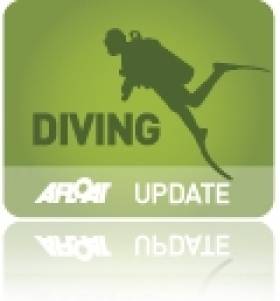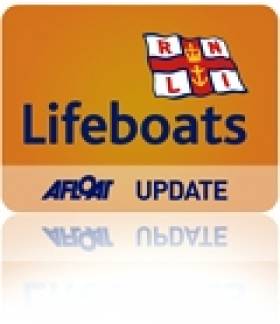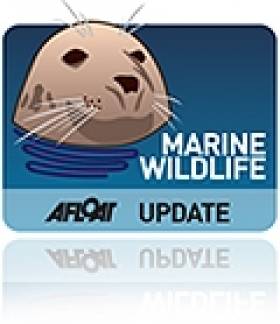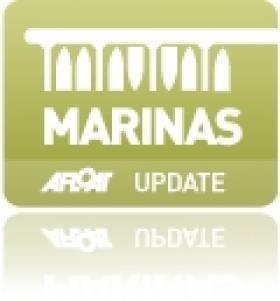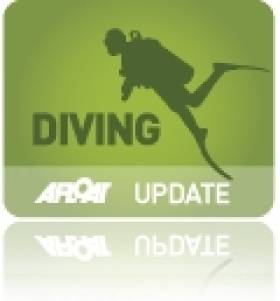Displaying items by tag: Donegal
Divers Search For Balls Sunk By Golfing Legend
#DIVING - Diver Gus O'Driscoll and four members of the Delta Specialist Diving Club are currently searching the bed of Lough Salt in Donegal for a number of golf balls driven into the water more than 100 years ago by the legendary Old Tom Morris.
The Belfast Telegraph reports that 20 of the golfer's own rubber balls were hit into the lake during an exhibition in 1891. Though worth a shilling a piece at the time, today they are worth a whopping €20,000 each.
The only obstacle in the path of the intrepid divers is the mountain of golf balls they have to sift through to find the exceedingly rare 'gutta perches'.
"There are literally thousands of balls at the bottom of Lough Salt because stopping off to hit golf balls there has been a tradition going back to Morris's time," said O'Driscoll.
If they do strike it lucky, the divers plan to donate their finds to the nearby Rosapenna Golf Club, whose course was designed by Old Tom himself.
Bilge Alarms Recommended for Fishing Vessels - MCIB
#MCIB - Bilge alarms in compartments below the water line have been recommended for fishing vessels in the official report into the sinking of the FV Amy Jane off Donegal last year.
As previously reported on Afloat.ie, the six-man crew of the crabber were rescued by coastguard helicopter some 13 miles off Malin Head on the morning of 7 October 2011 after the boat began taking on water overnight.
The vessel had left Greencastle Harbour in the early hours headed out to haul pots from the crab grounds off Malin Head when the crew discovered that the boat was down by the head. The pot store was found to be full of water, and attempts to pump it out made little difference.
The alarm was raised via radio with Malin Head Coast Guard before 9am and Irish Coast Guard helicopter Rescue 118 was tasked to the scene, lifting all six crew from the stricken vessel by 10.30am.
The report by the Marine Casualty Investigation Board (MCIB) found that corrosion within the Vivier tank system - used to preserve the boat's catch - was the likely source of the breach that led to the vessel taking on water.
Though an unusual thump or bump was noticed by the skipper on watch around 3am, nothing obvious was discovered, and neither the listing at the boat's head nor the flooding of the pot store - which had no bilge alarm - were noticed till after sunrise.
Aside from recommending the installation of bilge alarms for all compartments below the water line on fishing vessels, the report also called for consideration to include survey guidelines for Vivier systems, which are exposed to the same environment as the hull.
The full report on the Amy Jane incident is available to download via the link below.
RNLI Warns Over 'Bogus Santa' Collector
#RNLI - The RNLI has warned the public in Donegal to keep on the lookout after reports that a man in a Santa Claus outfit was falsely claiming to be collecting for the lifeboat charity at the weekend.
A spokesperson for the RNLI told the Donegal Democrat that Gardaí in Bundoran were alerted to a man soliciting donations throughout the popular surf town on Saturday and Sunday.
The RNLI confirmed that it has no collections going at present, though its crew members and volunteers will soon be selling tickets to a fundraising dinner dance in February 2013.
RNLI Bundoran adds:
Bundoran RNLI Lifeboat are today (Monday 19th November) warning members of the public to be aware of a man dressed in a Santa suit claiming to be doing a collection on behalf of the organisation in the local area.
Members of the voluntary organisation were made aware of the character on Sunday evening after a member of the public said that he had called to his house in the West End of the seaside resort. The Gardai were immediately notified and an alert issued to the public via the lifeboat station's social media pages.
Volunteer Fundraiser for Bundoran RNLI Lifeboat, Cormac McGurren said 'this news is particularly disturbing in this day and age and we would encourage anybody who is approached by this man to refuse to hand over any money to him and report him immediately to the local Gardai. Members of the RNLI doing any collection will always be carrying official RNLI branded buckets and wearing official clothing. We will shortly commence selling tickets for our annual dinner dance at the start of February but I can confirm that we currently have no collections operating in the Bundoran & Ballyshannon area'
Lifeboat Press Officer Shane Smyth added 'the RNLI is a very respected and trusted organisation in the area and we are constantly relying on the generosity of locals to keep the service funded year round so that we can save lives at sea. An incident such as this is particularly unhelpful and we would ask people to be vigilant'
MLA Seeks NI Minister's Support for Malin Head Coastguard
#COASTGUARD - An MLA for East Londonderry has sought the support of Northern Ireland's Minister of State to protect the Irish Coast Guard station at Malin Head from closure.
Inishowen News reports that the SDLP's John Dallat MLA contacted Mike Penning regarding the threat looming over the Donegal coastguard station, which is the most northerly on the island of Ireland.
Dallat said: “When Mike Penning was Minister for Transport in Westminster he was instrumental in keeping the coastguard station at Bangor, Co Down, open, and he made his judgement on the basis that Bangor had a special working relationship with Malin Head which was critical to ensuring there was a complete coverage of all areas."
“It would be ironic now if Malin Head, which saved Bangor, was itself to be victim of closure. That must not happen and I believe Mr Penning’s support is an important element in this campaign which must not fail."
As reported recently on Afloat.ie, coastal communities in both Donegal and Kerry have been protesting plans to close the stations at Malin Head and Valentia in the wake of a 'value for money' report commissioned by the Republic's Minister for Transport Leo Varadkar.
Coastguard chiefs have criticised the studies conducted by consultants Fisher Associates into the IRCG and the Marine Survey Office.
Inishowen News has more on the story HERE.
Lobster Skirmish Caught On Video
#MARINE WILDLIFE - For something a little unusual on this Bank Holiday Monday, check out this video of lobsters locked in a duel beneath the waves in Co Donegal.
This clash of crustaceans was captured on video by the Sheephaven Sub Aqua Club earlier this month at Mulroy Bay near Letterkenny.
New Facilities for Stranraer Marina Hoped to Boost Numbers
#MARINAS - The new shore block at Stranraer Marina is the latest project to benefit from the Sail West initiative across western Scotland, Northern Ireland and the northwest coast of Ireland.
As the Galloway Gazette reports, the new waterfront building comprises a permanent harbour office, coastguard base, showers and toilets, as well as a community education room.
“The ongoing development of the marina is key to branding Stranraer as a marine leisure destination," said local councillor Roberta Tuckfield.
"Plans to add more pontoons and another breakwater should bring in additional pleasure craft, increasing tourism numbers benefiting the whole town.”
The marina improvements have been made with the goals of boosting the number of marine leisure users in Stranraer, fitting in with Sail West and its cross-border MalinWaters marine tourism brand across the channel.
Sail West is an international scheme, headed by Donegal County Council and Larne Borough Council, which aims to encourage mariners to enjoy the North Channel coastlines of Scotland, Ireland and Northern Ireland.
Other projects recently supported under the rubric of the Sail West initiative include the new coastal marina facility at Ballycastle Harbour in north Antrim and this summer's Clipper Festival in Derry.
The Galloway Gazette has more on the story HERE.
Video Shows Divers Exploring Carinthia Wreck Off Donegal
#DIVING - WorldIrish have done it again with another great video find - this time following a team of divers off Donegal as they explore the wreck of the RMS/HMS Carinthia.
On 6 June 1940, during the Second World War, the transatlantic steam-powered cruise liner turned armed merchant ship was sunk by a German U-boat off Tory Island.
The video above shows some of the sights seen by Michael McVeigh and his diving team, including the ship's bow, the anchor telegraph and its wartime addition 6" gun.
Clare Does the Double at Surf Lifesaving Nationals
#SURFING - The Irish Independent reports that the cream of Ireland's lifeguards comepeted at the National Surf Lifesaving Championships at Rossnowlagh, Co Donegal at the weekend.
Some 140 top lifesavers took part in events featuring a combination of surfing, surf-skiing and beach sprinting on the sun-and-surf-splashed strand - part of the preparations for November's World Lifesaving Championships in Australia.
Teams from Co Clare took the men's and over-30s titles - following the county's success at the European Lifesaving Championships in Sweden last month - while the women's top spot went to locals Donegal.
"Surf lifeguards have vital skills and every part of their training was on display," event organiser Seamus O'Neill of Irish Water Safety told the Independent.
Donegal Coastguard's Cliff Rescue Service May Be Scrapped
#COASTGUARD - The Donegal Democrat reports that the northern county may soon lose the cliff rescue service supplied by the Bunbeg coastguard unit.
Irish Coast Guard spokesman Gerard O'Flynn confirmed that the recent Fisher Report commissined by Minister for Transport Leo Varadkar "recommends that the Bunbeg unit should just continue as a coastguard boat and search team and no longer offer the cliff rescue element of their operation."
He added: "There has been no decision taken on this. It is only contained in the report, it is at discussion level."
As previously reported on Afloat.ie, the same 'value for money' report has recommended the closure of both coastguard radio stations at Malin Head and Valentia Island.
The Bunbeg unit, which comprises 23 volunteers in total, covers much of the county's northwestern coastline from Rosbeg to Horn Head which has become a popular spit for climbers both on the mainland and offshore on the likes of Tory Island and Arranmore.
Dancing Dolphins Surprise Researchers Off Donegal
#MARINE WILDLIFE - Marine researchers off the coast of Donegal were recently treated to a rare dolphin dance by a 50-strong pod, as IrishCentral reports.
The video above captures the same pod witnessed by researchers with the Irish Basking Shark Project, who were in the area off Inishowen to observe basking sharks in the coastal waters when they were surprised by the gregarious dolphin congregation.
A spokesperson for the project confirmed to IrishCentral that such large groupings of dolphins are unusual for the area, which has welcomed more than its fair share of large marine wildlife over recent months.
As previously reported on Afloat.ie, one of the first confirmed sightings of killer whales on the Irish coastline was recorded earlier this summer when a family of orcas from the Scottish Hebrides visited the same waters at the mouth of Lough Swilly.
Meanwhile, WorldIrish reports on the heartwarming tale of a Dutch couple who have bonded with Dingle's most famous non-human resident, Fungie the dolphin.
Jeannine Masset and Rudi Schamhart, who now live in Annascaul, have visited the friendly cetacean for 21 years, and their connection has inspired a fanpage on Facebook that has received responses from Fungie fans around the world.
"Fungie has enriched our lives and we want to give something back to him by offering our friendship and companionship to him," said Jeannine, "and he lets us know over and over again that he really appreciates it."


























